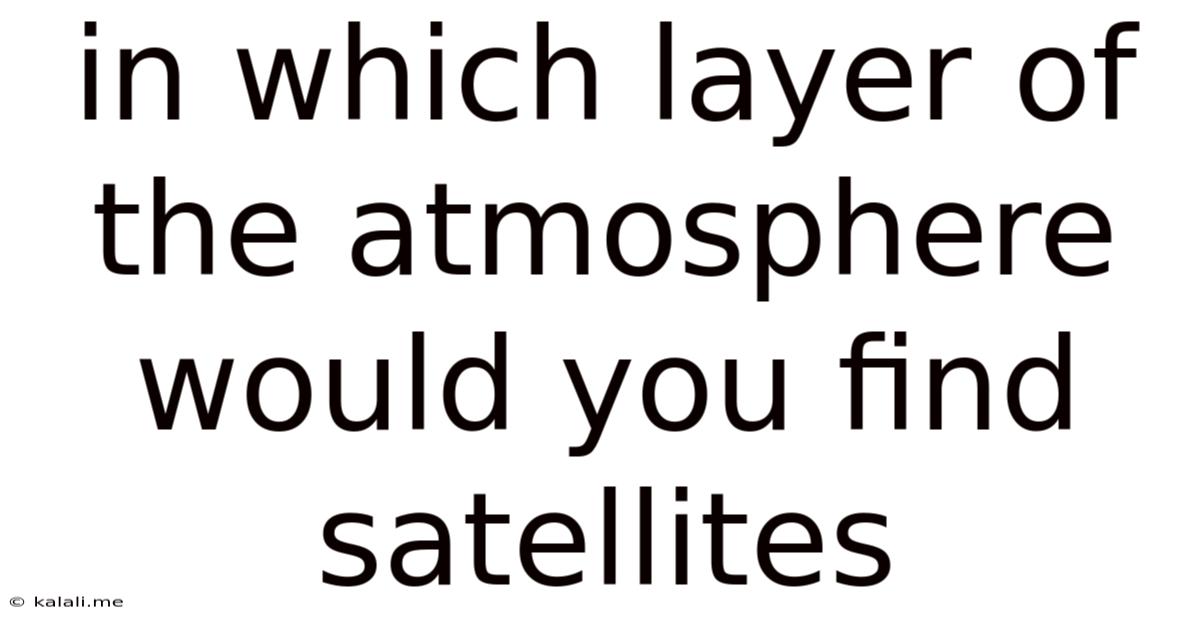In Which Layer Of The Atmosphere Would You Find Satellites
Kalali
Jun 11, 2025 · 3 min read

Table of Contents
In Which Layer of the Atmosphere Would You Find Satellites? Understanding Orbital Mechanics
Are you curious about where satellites orbit our planet? It's not quite as simple as saying they're "in space," as space itself begins at the Kármán line, approximately 100 kilometers (62 miles) above sea level. Satellites, however, operate within specific layers of Earth's atmosphere and beyond, depending on their function and purpose. This article will explore the atmospheric layers and clarify where you'll most likely find orbiting satellites.
Understanding Earth's Atmospheric Layers
Before we pinpoint satellite locations, let's quickly review the layers of Earth's atmosphere:
- Troposphere: This is the lowest layer, extending up to about 7-20 kilometers (4-12 miles), depending on latitude. It contains most of the Earth's weather systems and air we breathe.
- Stratosphere: This layer stretches from the tropopause (the boundary between the troposphere and stratosphere) to about 50 kilometers (31 miles). It's home to the ozone layer, which absorbs harmful ultraviolet radiation.
- Mesosphere: Extending from 50 to 85 kilometers (31 to 53 miles), the mesosphere is where most meteors burn up. Temperatures here are extremely cold.
- Thermosphere: This layer reaches from 85 to 600 kilometers (53 to 372 miles) and is characterized by extremely high temperatures due to absorption of high-energy solar radiation. The ionosphere, a region where gases are ionized by solar radiation, is located within the thermosphere.
- Exosphere: This is the outermost layer, gradually fading into the vacuum of space. It extends to about 10,000 kilometers (6,200 miles).
Where Satellites Orbit: Beyond the Atmosphere
Satellites are primarily found beyond the thermosphere, in the region considered outer space. While the exosphere is technically still part of Earth's atmosphere, it's so tenuous that it has negligible impact on satellite operations. Therefore, we can say satellites orbit in the region beyond the thermosphere, in what's generally referred to as low Earth orbit (LEO), medium Earth orbit (MEO), and geostationary orbit (GEO).
-
Low Earth Orbit (LEO): Satellites in LEO typically orbit between 160 and 2,000 kilometers (100 and 1240 miles) above the Earth's surface. This altitude allows for high-resolution imaging and quick data transmission. Many weather satellites, Earth observation satellites, and the International Space Station are in LEO.
-
Medium Earth Orbit (MEO): MEO satellites orbit at altitudes between 2,000 and 35,786 kilometers (1240 and 22,236 miles). Navigation satellites, such as those used in the GPS system, often occupy MEO.
-
Geostationary Orbit (GEO): Satellites in GEO orbit at an altitude of approximately 35,786 kilometers (22,236 miles) above the equator. At this altitude, their orbital period matches the Earth's rotation, making them appear stationary from the ground. Many communication satellites and weather satellites use GEO.
Factors Influencing Satellite Altitude:
The altitude of a satellite's orbit is carefully chosen based on its purpose. Lower orbits provide higher resolution images and quicker data transfer but are subject to more atmospheric drag, requiring more frequent orbital adjustments. Higher orbits, such as GEO, offer greater coverage but require more powerful communication systems.
In conclusion, while the upper reaches of the atmosphere extend far beyond the thermosphere, the vast majority of operational satellites reside in orbits well beyond the thermosphere, in LEO, MEO, or GEO. The specific orbit depends on the satellite's mission and operational requirements.
Latest Posts
Latest Posts
-
How Many Quarters Are In An Ounce
Jul 01, 2025
-
How Many Times Does 11 Go Into 40
Jul 01, 2025
-
Elvis Presley Gospel One Pair Of Hands
Jul 01, 2025
-
What Is The Fine For Killing A Buzzard
Jul 01, 2025
-
How Old Am I If I Was Born In 1996
Jul 01, 2025
Related Post
Thank you for visiting our website which covers about In Which Layer Of The Atmosphere Would You Find Satellites . We hope the information provided has been useful to you. Feel free to contact us if you have any questions or need further assistance. See you next time and don't miss to bookmark.